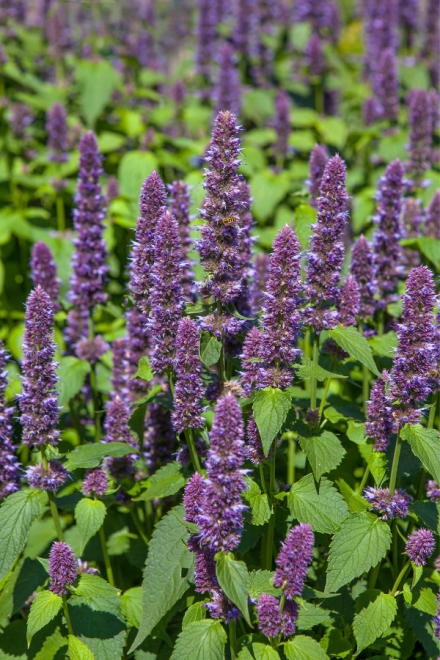Ready to enjoy a homegrown cup of tea?
Published 9:30 am Tuesday, May 20, 2025

- TIME FOR TEA: Anise Hyssop will bring a new dimension to after dinner tea with its peppermint leaves. (National Garden Bureau)
“As full of spirit as the month of May, and as gorgeous as the sun in Midsummer.” – William Shakespeare.
“Another May new buds and flowers shall bring: Ah! why has happiness no second Spring?” – Charlotte Smith.
“May is the most beautiful month of the year, a month alive with warm color. The flowers and trees are in full bloom, and even the sun joins this rhapsody be emitting warmer rays.” – Lillian Berliner.
Trending
“Then you have to remember to be thankful; but in May one simply can’t help being thankful that they are alive, if for nothing else.” – L. M. Montgomery.
There is nothing better than drinking a delicious cup of tea. Except, drinking a cup made from plants grown in your own garden. Ditch the classics and get ready for your new home-grown favorites! Ten favorite plants to grow and use in your tea garden include:
Lemongrass: Towering in the garden, lemongrass is truly a unique plant. Its’ stems create an oil rich in lemony flavor. Brewed in hot water, add it to your Arnold Palmer (combination of iced tea and lemonade) for a fresh, zany taste. To harvest, cut lemongrass stalks. Be careful as the leaves are sharp and can give unexpected papercuts! Stalks can be air-dried, dried in the oven at low heat, or put in a dehydrator
To use, collect three pinches (depending on your taste) of fresh lemongrass leaves in a teapot or teacup. Steep for 3 minutes and blend lemongrass with calendula to aid digestion.
Anise Hyssop: Native to the mint family, Anise hyssop is the perfect combination to go with straight peppermint or spearmint leaves. Need a new addition for an after-dinner tea? Anise will take the gold, it’s licorice flavor will bring a new dimension to your favorite bedtime cup. Use the leaves and flowers fresh or dried. To harvest, collect anise leaves at any time during their growing season to use fresh. Or, wait for the flowers to bloom in June/July and use both the flowers and the leaves. To use, tear 2-3 leaves into boiled water and steep for 10 minutes. Blend with rose hips to help with coughs and colds. After flowering, cut back the Anise plant for a second flush of flowers to enjoy later in the season.
Stevia: Stevia, a natural sweetener, is cultivated all over the world, but growing your own will make it that much sweeter. To harvest, collect stevia leaves before flowering to use fresh. Dry the leaves by hanging them in a cool, dark place. To use, pinch 5-6 leaves into boiled water and steep for 3 to 4 minutes.
Trending
Blend with mint, lemon balm, rose hip, and sage to create the perfect summer drink. The sweetness of stevia will vary and tends to be stronger later in autumn before the plant flowers.
Cinnamon basil: Yes, you read that right! Cinnamon basil is a basil plant that tastes like cinnamon. With dark green leaves and stunning purple flowers, it’s a show-stopper in any garden. (it’s perfect in fresh flowered bouquets, too!). In tea, it’s a favorite basil to use. Why? Because it doesn’t taste like you’re drinking pesto… instead, you are drinking a spiced cinnamon tea. To harvest, collect cinnamon basil leaves at any time during their growing season to use fresh. Flowers will bloom in June/July and then use both flowers and leaves in your tea. To use, tear 2 stems with leaves into boiled water and steep for 3 minutes.
Use to help with digestion. Use the leaves, flowers, and soft stems to make a cup of delicious basil tea.
Echinacea: Bring an earthy taste to the summer months with Echinacea tea. To harvest, collect flower heads when they first start to open. Echinacea roots and leaves may also be used to make tea. To use, steep flowers, leaves, and roots for 15 minutes. A popular remedy for colds, flu, and other infections, as it is thought to help boost immunity.
Lavender: Lavender is having its’ time in the sun. It’s everywhere from flower crowns to lemonades and its distinctive scent is found in soaps and massage oils. Lavender tea has been used for centuries in traditional medicine to boost mood and enhance calm. Create your own sip of paradise. To harvest, collect fresh lavender at any time during the growing season. Also, include the lavender flowers when in bloom.
Dry lavender flowers and leaves for winter tea. To use, steep flowers and leaves for 10 minutes.
Beneficial in aiding restless sleepers. You’ll need about two teaspoons of lavender buds for every eight-ounce cup of water. Use only one tablespoon for dried lavender.
Calendula: One of the oldest cultivated flowers, Calendula dates back to Roman times. Whether it’s beautiful fresh arrangements or pops of color in the garden, Calendula will also be a much-loved addition to your tea assortment with its earthy, peppery bite. To harvest, collect calendula flowers regularly during the growing season for consistent flowering. Pick the petals off of the flowers to make dry tea. To use, steep fresh flowers or a pinch of dried petals in boiling water for 4 minutes. Calendula is high in Vitamin C and good for the digestive system.
Violet: A hidden delight in your garden, these flowers make the perfect pairing to any tea. Believed to comfort and strengthen the heart, violets sweet floral taste is perfect for any warm cup of tea. To harvest: flowers will bloom during spring and fall. Once in full bloom pinch off the flowers with your fingertips.
To use, steep flowers and leaves for 3 minutes. Blend with myrtle to help sinus discomfort. Violets make a refreshing iced tea as well. Use plenty of flowers when brewing a pitcher.
Dianthus: In the peak of summer, Dianthus stuns gardens with its beautiful blooms. They remind me of little carnations ready to be picked for posey bouquets. Not just a beautiful flower, but a sweet taste, similar to cloves in tea. To harvest, collect flowers in spring and summer when in bloom. To promote new growth and more blooms, prune back the plant in early spring. Dry flowers for delicious tea throughout the year.
To use, steep flowers for 5 minutes. Blend with cinnamon for a holiday tea treat.
Dahlia: With a range of colors, dahlias make a killer statement piece in any garden. Their delightful taste makes a great summer tea. To harvest, cut when blooms are ¾ of the way open, but not overly ripe. You are looking for firm and lush petals versus papery ones. Dry dahlia flowers to make tea throughout the winter months. To use, steep flowers for 3 minutes. Blend with calendula or other summer flowers to create a wonderful summer drink. Check the Dahlia blooms carefully for bugs before using them for tea. Many insects like to hide in their tubular-shaped petals.
Ready to enjoy a homegrown cup of tea? Go for it! The information here is intended for inspirational and educational purposes only. Please consult a healthcare professional before considering any herbal treatments.
“They all joined together constantly in prayer, along with the women and Mary the mother of Jesus, and with his brothers.” Acts 1:14. “If any of you lacks wisdom, he should ask God, who gives generously to all without finding fault, and it will be given to him.” James 1:5. “Do not be wise in your own eyes; fear the Lord and shun evil.” Proverbs 3:7. “Who is wise and understanding among you? Let him show it by his good life, by deeds done in the humility that comes from wisdom.” James 3:13. “Search me, O God, and know my heart; test me and know my anxious thoughts. See if there is any offensive way in me, and lead me in the way everlasting.” Psalm 139:23-24.






